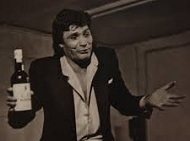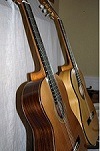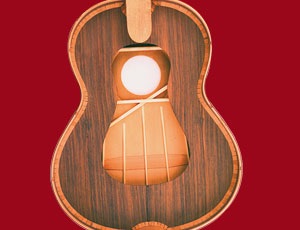Welcome to one of the most active flamenco sites on the Internet. Guests can read most posts but if you want to participate click here to register.
This site is dedicated to the memory of Paco de Lucía, Ron Mitchell, Guy Williams, Linda Elvira, Philip John Lee, Craig Eros, Ben Woods, David Serva and Tom Blackshear who went ahead of us.
We receive 12,200 visitors a month from 200 countries and 1.7 million page impressions a year. To advertise on this site please contact us.
|

|
|
Guitar Physics
|
You are logged in as Guest
|
|
Users viewing this topic: none
|
|
Login  | |
|

   
estebanana
Posts: 9354
Joined: Oct. 16 2009

|
 RE: Guitar Physics (in reply to jmb) RE: Guitar Physics (in reply to jmb)
|
|
|
There's a saying:
"Luthiery is not rocket science, it's harder."
________________
Read Alan Carruth's works, he is vetted and does not do dumb experiments. His work is carefully done and checked, and he works on problems that have practical applications in real building. His stuff is pretty solid and some of it is quite difficult to read unless you have some advanced science background.
In particular his study of saddle break angle is excellent and his big work called 'String Theory' is very good. Despite the obvious pun in the title, it is an exhaustive look at guitar strings in tension, motion, structure and what happens to them as they move. He figures out some things we already knew by ear, and few new things we did not know.
Some people also swear by the book of the Australian called Trevor Gore, but he kind of uses the research to support a proprietary bracing system and the cost is prohibitive for casual reading. But he did a lot of work.
One thing to remember is that many things on the guitar seem provable with physics, yet in practice the guitar does not actually function as is is proved out to function. Like if you think the treble side of the bridge and treble side fan braces control the treble strings you would be scientifically wrong. Yet there is some bearing to the common sense visual logic as it applies to guitar function. It is truly a strange and contradictory box.
And the tone generation science where makers excite the guitar with a tone to see how the various points resonate. That stuff does work to a degree, but good guitars also don't adhere to the same parameters that other good guitars show. There are different kinds of 'good' guitars. Carruth says, we know how to make a good guitar almost every time after looking at the research, but we are still figuring out how to make a great guitar.
The great guitar is probably not possible to quantify, good guitars fall into some what calculable ranges.
After nearly 500 years, violinmakers are still not clear on why the bass bar functions. They know if you whittle it here or there it changes the violin a bit, but not really why.
_____________________________
https://www.stephenfaulkguitars.com
|
|
|
|
REPORT THIS POST AS INAPPROPRIATE |
Date Dec. 17 2014 1:56:37
 |
|

   
Richard Jernigan
Posts: 3431
Joined: Jan. 20 2004
From: Austin, Texas USA

|
 RE: Guitar Physics (in reply to Ricardo) RE: Guitar Physics (in reply to Ricardo)
|
|
|
I read Ramirez's book after I had spoken to him a number of times in the process of buying over a period of a few years about a dozen 1a classicals, which I imported to the USA. As a practicing physicist and engineer, I could not see where his ideas had a scientific foundation. All the same, he produced fine guitars, and I still love my '67 1a blanca.
Carruth, on the other hand, strikes me as a very well informed 'scientific' luthier, who has performed a number of ingenious experiments that shed light on topics not readily accessible to calculation. Any engineer or physicist will know that a calculation is not to be trusted unless verified by experiment. Carruth sums up by saying, "Through measurements we can tell a good guitar from a bad guitar, but we can't tell a good guitar from a great guitar."
RNJ
|
|
|
|
REPORT THIS POST AS INAPPROPRIATE |
Date Dec. 17 2014 15:21:32
 |
|

   
Richard Jernigan
Posts: 3431
Joined: Jan. 20 2004
From: Austin, Texas USA

|
 RE: Guitar Physics (in reply to jmb) RE: Guitar Physics (in reply to jmb)
|
|
|
Grain pattern in guitar tops: One of the most famous classical guitars of the 20th century is Julian Bream's 1973 Jose Romanillos. I have seen it up close. The grain lines are spaced quite widely in the center, for a guitar top. The spacing narrows toward the outer edges, then widens again. I own the guitar made just before this one. The top looks like it could be the next board in the flitch to Bream's. In an article by Kevin Aram in the Journal of American luthiery, Romanillos is quoted saying guitar tops were hard to come by in England at the time. He resorted to re-sawing 'cello tops.
The well known Mexican luthier Abel Garcia Lopez studied with Romanillos, and twice served as his assistant at his guitar making course at Guijosa in Spain. When I visited Garcia to order a guitar from him he showed me some tops Romanillos had given him from early in Romanillos's career. They were obviously from the same flitch of the tree as Bream's guitar and mine.
When I ordered from Garcia he offered a selection of backs and sides to choose from. I chose, but I said, "Maestro, you are the expert, you pick the top." He chose a piece of perfectly quarter sawn spruce with very fine straight grain. He said the wood from Romanillos would have been as good, but it might have made my guitar a little harder to sell if I wished to.
(I don't want to sell it.)
RNJ
|
|
|
|
REPORT THIS POST AS INAPPROPRIATE |
Date Dec. 17 2014 15:39:41
 |
|
 New Messages New Messages |
 No New Messages No New Messages |
 Hot Topic w/ New Messages Hot Topic w/ New Messages |
 Hot Topic w/o New Messages Hot Topic w/o New Messages |
 Locked w/ New Messages Locked w/ New Messages |
 Locked w/o New Messages Locked w/o New Messages |
|
 Post New Thread
Post New Thread
 Reply to Message
Reply to Message
 Post New Poll
Post New Poll
 Submit Vote
Submit Vote
 Delete My Own Post
Delete My Own Post
 Delete My Own Thread
Delete My Own Thread
 Rate Posts
Rate Posts
|
|
|
Forum Software powered by ASP Playground Advanced Edition 2.0.5
Copyright © 2000 - 2003 ASPPlayground.NET |
0.0625 secs.
|


 Printable Version
Printable Version












 : the trees.
: the trees. 
 New Messages
New Messages No New Messages
No New Messages Hot Topic w/ New Messages
Hot Topic w/ New Messages Hot Topic w/o New Messages
Hot Topic w/o New Messages Locked w/ New Messages
Locked w/ New Messages Locked w/o New Messages
Locked w/o New Messages Post New Thread
Post New Thread